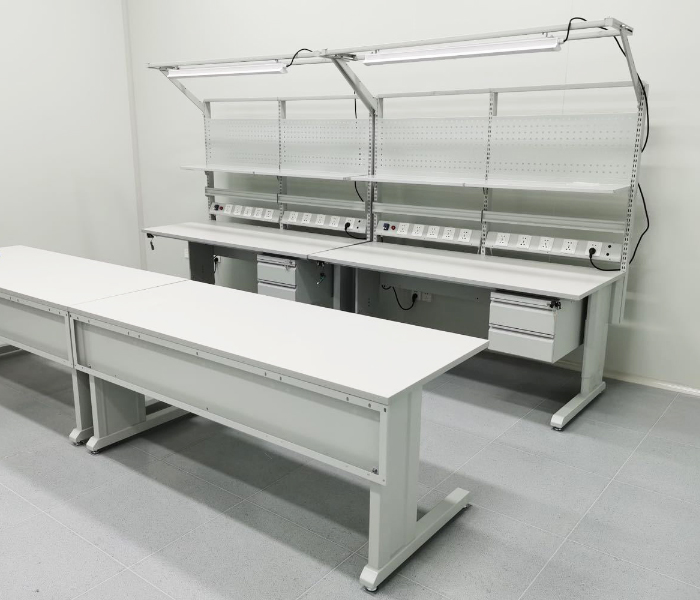Table of Contents
Electrostatic discharge (ESD) is a common issue in workplaces dealing with sensitive electronic components. To minimize the risks associated with ESD, it’s essential to use specialized furniture like an ESD workbench. In this ultimate guide, we’ll delve into everything you need to know about ESD workbenches, from their definition and benefits to the materials and compliance requirements.
The Definition of ESD Workbench
An ESD workbench is a specially designed workstation that minimizes the build-up of static electricity, which can potentially damage sensitive electronic devices or components. ESD workbenches are typically used in industries such as electronics manufacturing, repair shops, laboratories, and any environment where electrostatic discharge can pose a risk to equipment or product quality.
The bench includes various grounding elements, anti-static materials, and surfaces that dissipate static energy safely, preventing costly damage to devices or components.
Why You Need an ESD Workbench?
Protect Sensitive Electronics
In industries where sensitive electronic devices are handled, even a small static discharge can cause damage. An ESD workbench ensures that your workspace is a safe zone for handling these devices, preventing latent defects or outright failures.
Enhance Product Quality
By eliminating ESD risks, you significantly reduce the chances of product malfunctions and improve overall quality. For manufacturers and repair facilities, using ESD-safe equipment such as an ESD workbench is essential for maintaining high standards.
Compliance and Safety
ESD workbenches are also critical for businesses that need to comply with safety and industry regulations, particularly ANSI/ESD S20.20, which governs the control of ESD in work environments.
The Material of ESD Workbench Worktop
The worktop material is one of the most important aspects of an ESD workbench. The material must be designed to both resist and dissipate static charges safely. Common materials include:
- Laminate with ESD properties: These are typically used for their durability and cost-effectiveness. The surface contains layers of static-dissipative material.
- Stainless Steel: Known for its longevity, stainless steel is often used in labs and environments where durability is paramount. However, additional ESD treatments are needed to ensure static dissipation.
- Phenolic Resin: This is a non-conductive, durable material often used in cleanroom environments. It can be treated to have static-dissipative properties.
- Rubberized ESD Mats: Some worktops are equipped with replaceable ESD mats that are designed to dissipate static electricity safely.
Types of ESD Workbenches
ESD workbenches come in various types, depending on the specific application and workspace requirements:
- Adjustable ESD Workbench: These benches can be customized in height to accommodate different workers or tasks, making them ergonomically friendly.
- Mobile ESD Workbench: Equipped with wheels, these benches offer flexibility and mobility in work environments that need adaptable workspaces.
- Fixed ESD Workbench: These are the more traditional, stationary workbenches designed for assembly lines or permanent workspaces.
- Modular ESD Workbench: This type of workbench allows for easy expansion and reconfiguration, offering maximum flexibility for growing or changing workspaces.
Applications of ESD Workbench
ESD workbenches are used in a wide range of industries, including:
- Electronics Manufacturing: Assembly lines where electronic components are put together require strict control of ESD to prevent product damage.
- Research and Development Labs: Any lab handling delicate electronic testing equipment benefits from ESD-safe workbenches.
- Repair Centers: ESD workbenches are crucial for facilities repairing electronics, such as computers, smartphones, and other gadgets.
- Cleanrooms: In environments where air quality and static control are critical, ESD workbenches are a key component in maintaining both.
The Difference Between ESD Workbenches and Common Workbenches
At first glance, an ESD workbench may seem similar to a regular workbench, but they are engineered with very specific differences.
- Static Control: ESD workbenches are designed with anti-static properties, typically using special materials for the worktop and grounding mechanisms to prevent static buildup. Common workbenches do not provide this level of protection.
- Grounding Systems: ESD workbenches include grounding systems, either through the worktop or the entire frame, ensuring any static is safely dissipated. This feature is not found in standard workbenches.
- Cost: ESD workbenches are typically more expensive than standard workbenches due to the specialized materials and construction required for static control.
The Requirements for Compliance with ANSI/ESD S20.20
Compliance with ANSI/ESD S20.20 is crucial for businesses dealing with ESD-sensitive products. This standard outlines the requirements for an Electrostatic Discharge Control Program, and ensuring your workbenches meet these requirements is a major part of staying compliant.
Key compliance features of an ESD workbench include:
- Surface Resistivity: The workbench should have a surface resistivity in the dissipative range, typically between 10^6 to 10^9 ohms. This ensures safe dissipation of static electricity.
- Grounding System: The workbench must be equipped with a reliable grounding system that ensures any static buildup is safely redirected away from the workspace.
- Regular Testing: To maintain compliance, regular testing of the workbench’s static control features is necessary. This includes checking the resistivity of the work surface and verifying the grounding system.
By following ANSI/ESD S20.20 guidelines, you not only protect your products but also ensure a safer work environment for your employees.
Conclusion
An ESD workbench is an essential tool for any environment that handles sensitive electronic equipment. From improving product quality to ensuring compliance with safety standards, ESD workbenches play a crucial role in modern manufacturing, labs, and repair centers. When choosing an ESD workbench, understanding the different materials, types, and applications will help you make the best decision for your specific needs.
With this guide, you’re now equipped with the knowledge to invest in an ESD workbench that will enhance both safety and productivity in your workspace.
If you are looking an ESD workbench, welcome to contact us.




